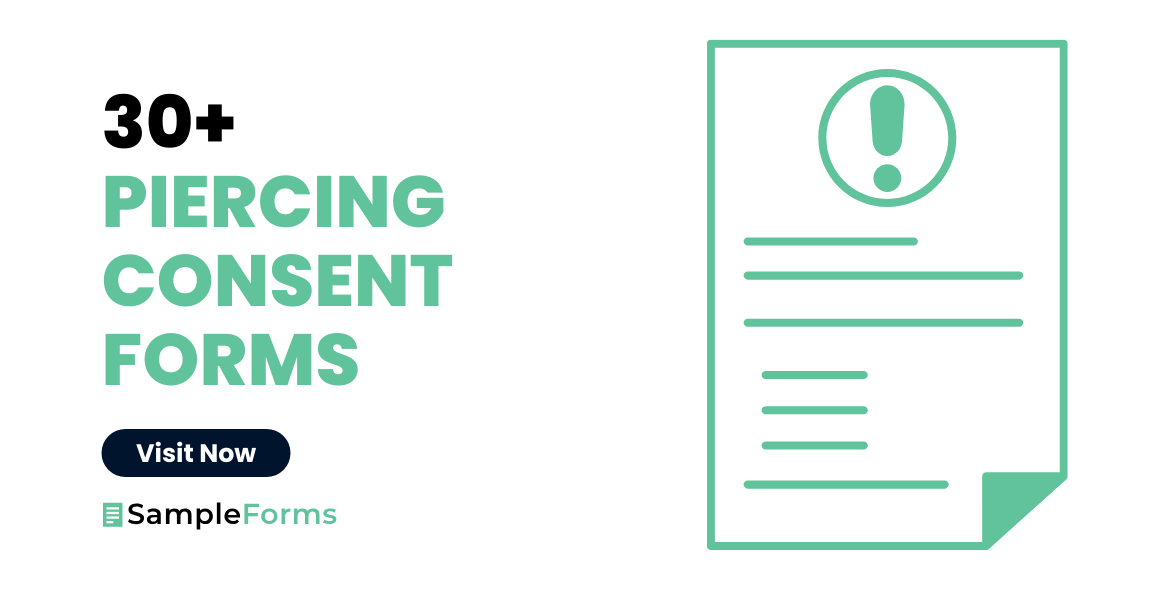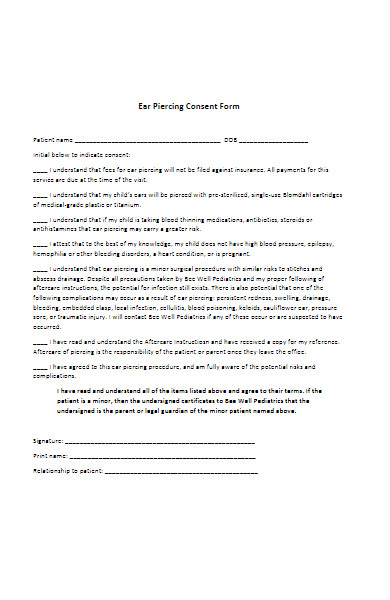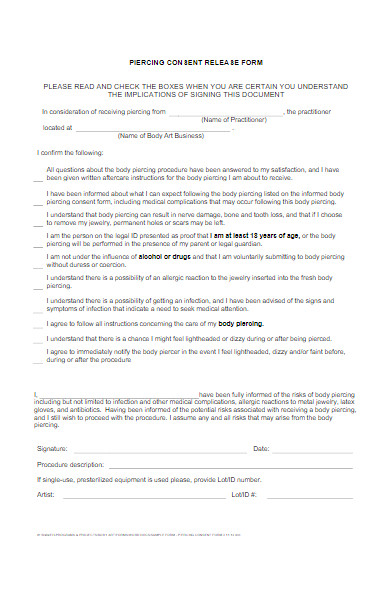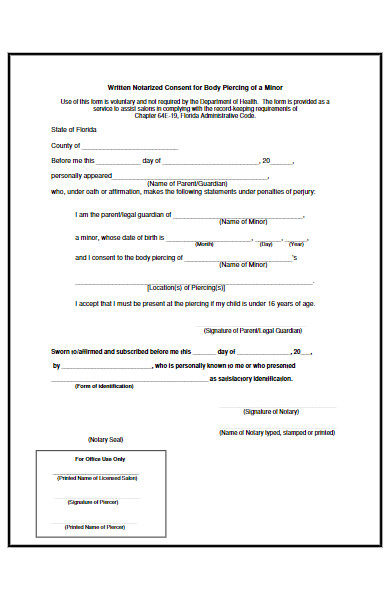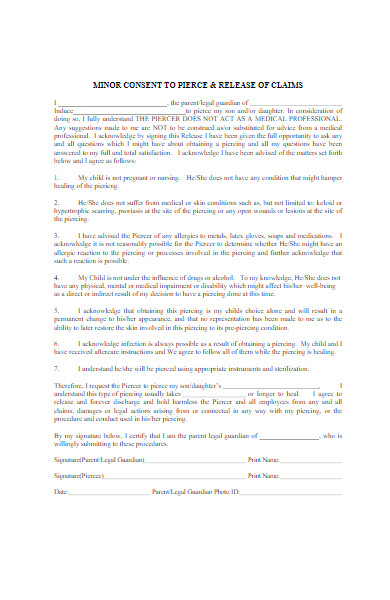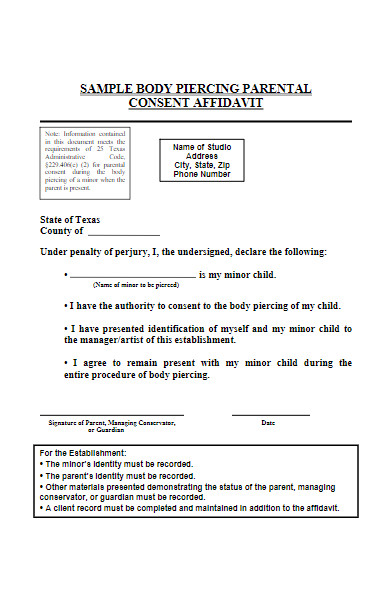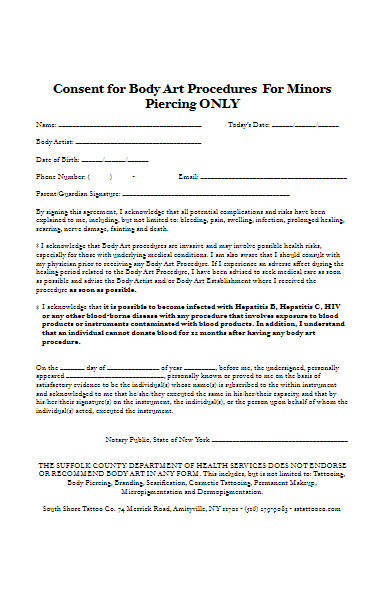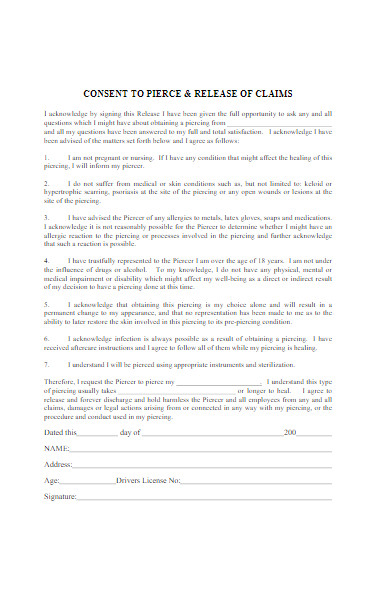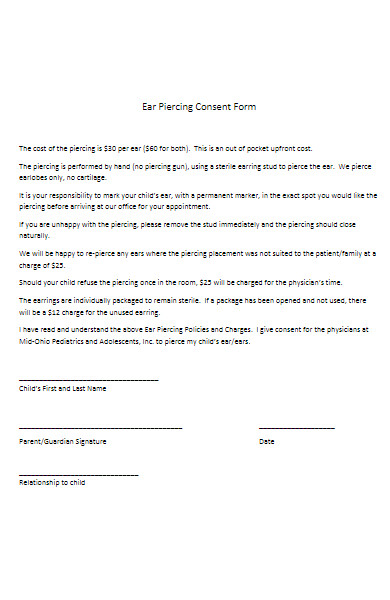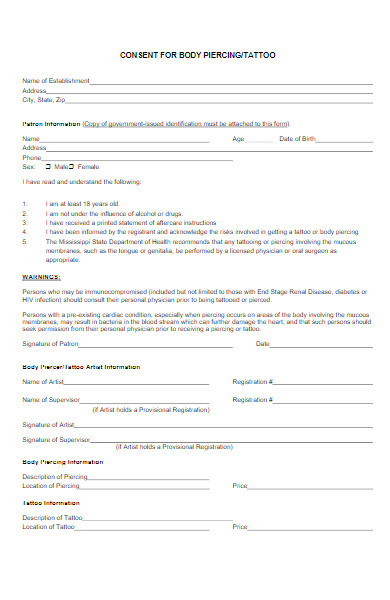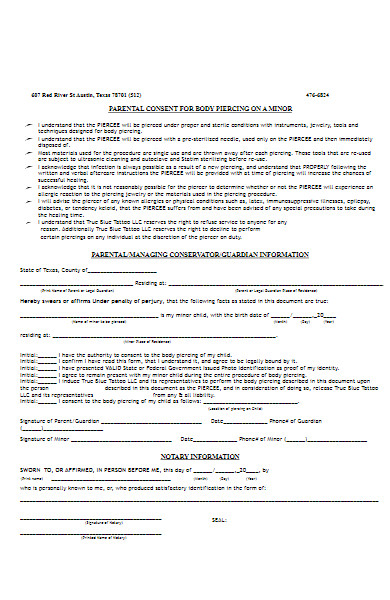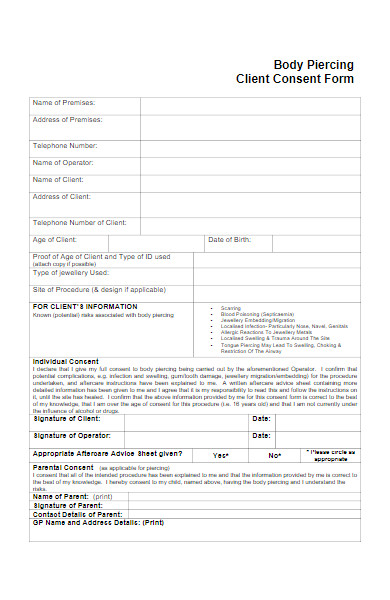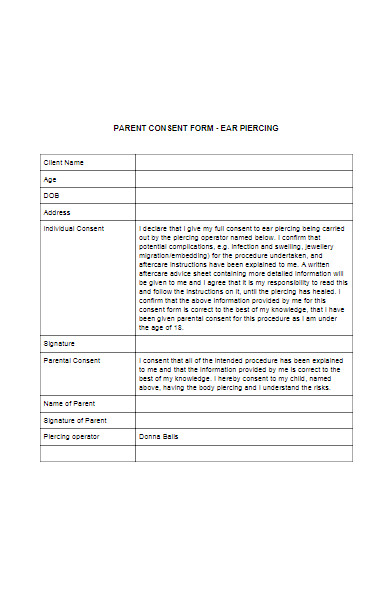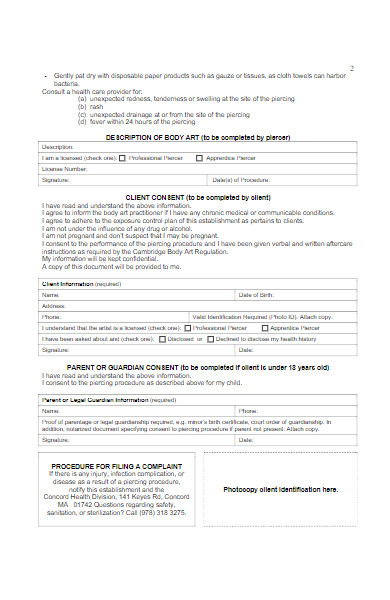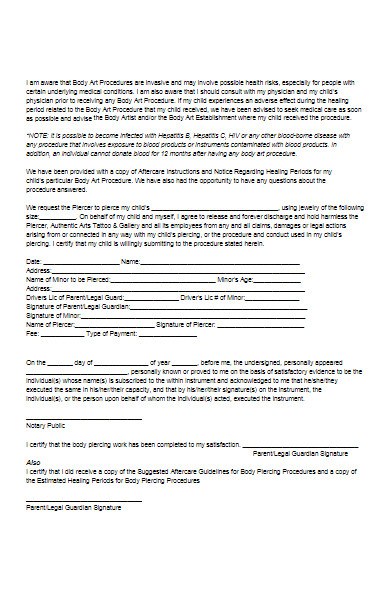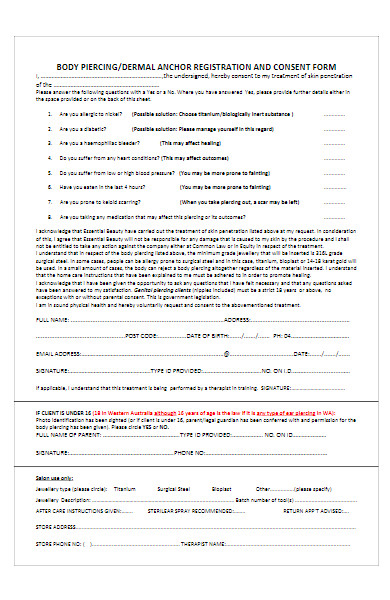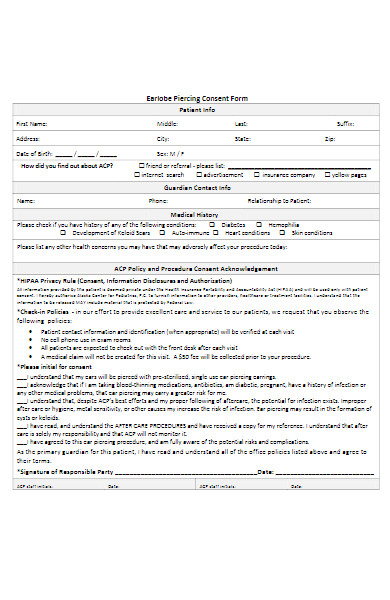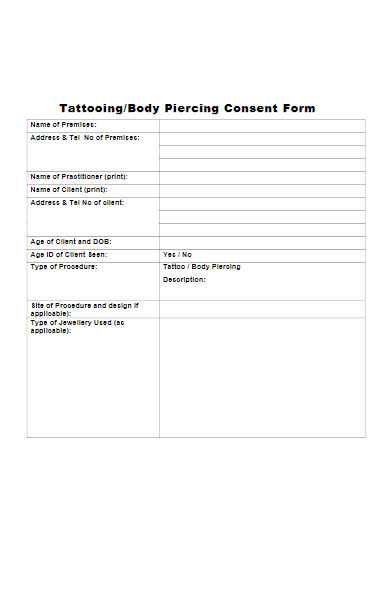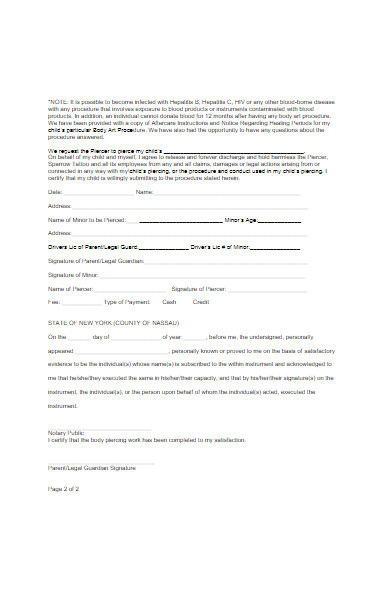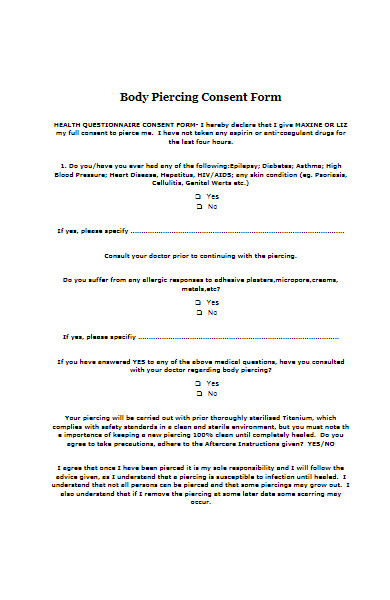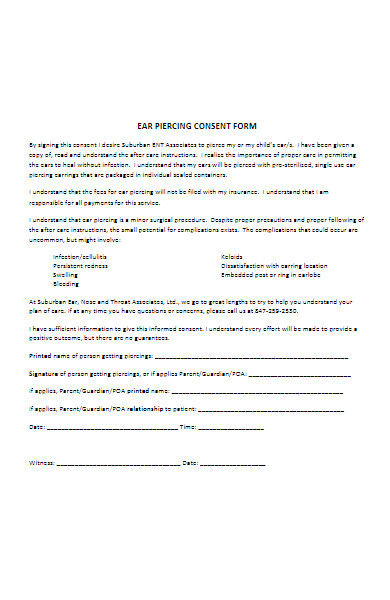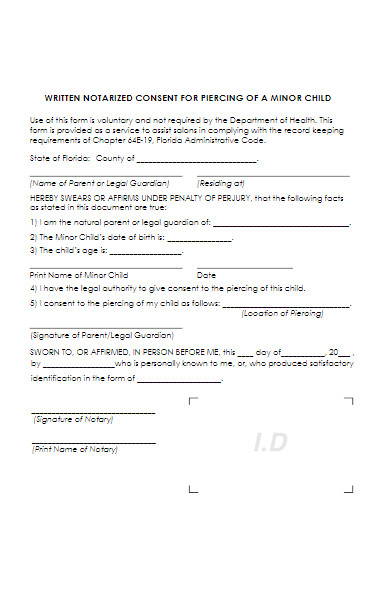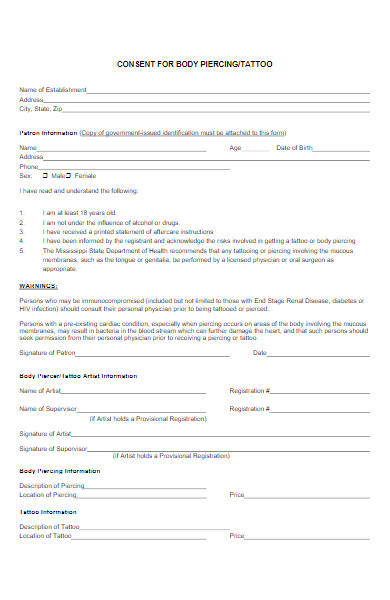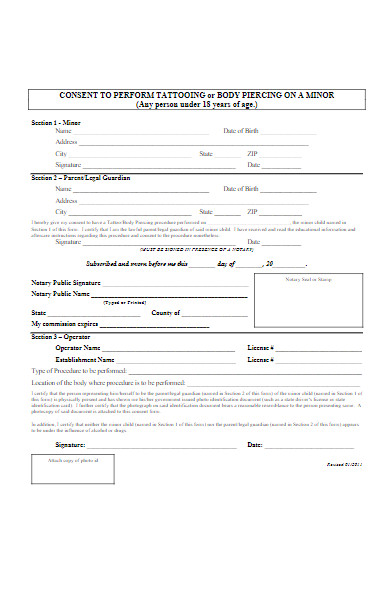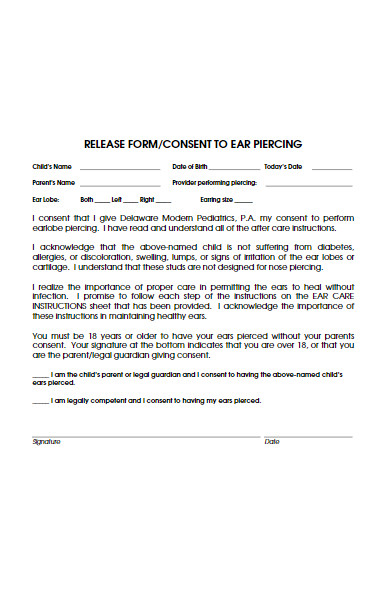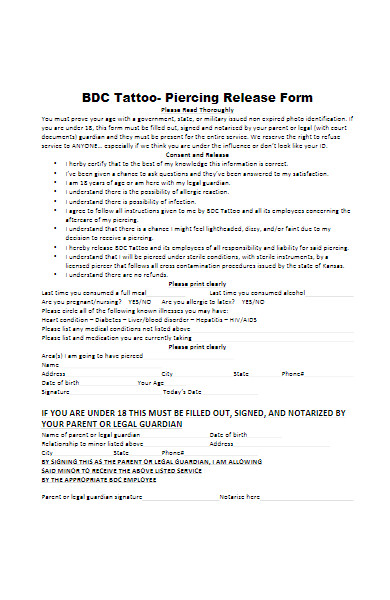A Piercing Consent Form: Ensuring Safe and Stylish Body Modifications Body piercing is a popular form of self-expression, but it’s essential to prioritize safety. A Piercing Consent Form plays a crucial role in this process. In this comprehensive guide, we’ll explore the meaning, types, examples, and offer step-by-step instructions on creating one. Plus, we’ll provide valuable tips to make sure your body piercing journey is both stylish and safe. Whether you’re a piercee or a piercer, understanding this form is a must.
What is a Piercing Consent Form? – Definition
A Piercing Consent Form is a legal document that individuals sign before undergoing any form of body piercing procedure. This form outlines the specific details of the piercing, the associated risks, and the responsibilities of both the piercee and the piercer. It serves as a written agreement form , ensuring that the procedure is performed with informed consent, promoting safety, and reducing potential legal liabilities for the piercing studio.
What is the Meaning of the Piercing Consent Form?
The Piercing Consent Form holds significant meaning in the world of body modification. It represents a crucial step in the process of getting a piercing, serving as a legal and ethical document. These printable form signifies that the individual willingly consents to the procedure, understanding the associated risks and responsibilities. It ensures that the piercing is conducted with informed consent, prioritizing safety and legal compliance. Essentially, the Piercing Consent Form symbolizes the commitment to a safe and responsible body piercing experience.
What is the Best Sample Piercing Consent Form?
A comprehensive Piercing Consent Form should encompass the following key components:
1. Personal Information:
- Full legal name of the piercee.
- Date of birth.
- Contact details, including address, phone number, and email.
2. Piercing Details:
- Specify the type of piercing (e.g., ear, nose, tongue, belly button).
- Provide exact details of the location (e.g., left earlobe, right nostril).
3. Risks and Complications:
- A thorough list of potential risks associated with the specific piercing, such as infection, swelling, bleeding, scarring, allergic reactions, and nerve damage.
- Explanation of the importance of proper aftercare to minimize risks.
4. Aftercare Instructions:
- Clear, step-by-step aftercare guidelines to ensure the proper healing and maintenance of the piercing.
- Include information on cleaning, avoiding certain activities, and recognizing signs of infection or complications.
5. Consent Statement:
- A prominent section where the piercee acknowledges that they have read and comprehended the risks and potential complications.
- Confirmation that the piercee is giving informed consent for the procedure.
6. Release of Liability:
- A section outlining the limitations of liability for the piercing studio or piercer.
- Emphasize that the piercee assumes responsibility for any complications or risks associated with the piercing.
7. Studio Information:
- Name and address of the piercing studio.
- Contact details, including phone number and email.
- Signature of the piercer, indicating their commitment to following industry standards and providing accurate information.
8. Witness Statement:
- Space for a witness to sign, confirming that they observed the piercee’s consent and the completion of the form.
9. Date and Signatures:
- Areas for the piercee, piercer, and witness to sign and date the form, indicating their agreement, understanding, and consent.
10. Emergency Contact: – Collect the name and contact information of an emergency contact person to ensure prompt communication in case of unforeseen complications.
Always keep in mind that the best sample Piercing Consent Form should adhere to local regulations and be adaptable to meet the specific needs of the piercing studio. This comprehensive document plays a pivotal role in safeguarding both parties involved and promoting a secure and responsible piercing experience.
FREE 30+ Piercing Consent Forms in PDF
31. Piercing Supplemental Application Consent Form
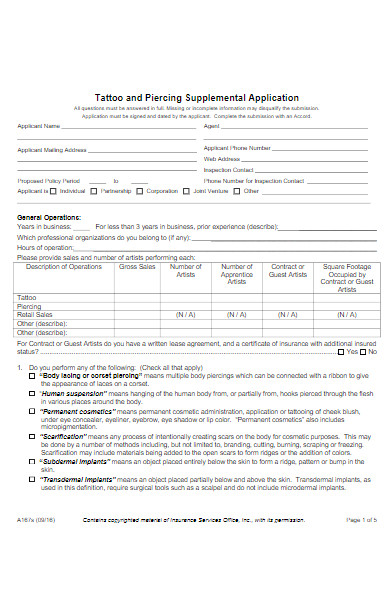
Why do I need to fill out a Piercing Consent Form?
Filling out a Piercing Consent Form is a crucial step in the piercing process for several reasons:
- Informed Consent: It ensures that you, as the client, are fully informed about the piercing procedure, associated risks, and aftercare instructions.
- Liability Protection: For piercing studios, the consent form serves as a legal document that demonstrates you have willingly consented to the procedure. It helps protect the studio from potential legal issues in case of complications.
- Health and Safety: The form may ask about your medical history and allergies, allowing the piercer to assess any potential health risks or complications.
- Aftercare Guidelines: It provides you with clear instructions on how to care for your piercing post-procedure, promoting a safe and hygienic healing process.
- Record Keeping: Studios maintain copies of these forms for their records, which can be useful for reference in case of any future issues or inquiries.
In summary, a Piercing Consent Form is a crucial tool to ensure transparency, safety, and legal protection for both the client and the piercing studio.
What information is typically included in a Piercing Consent Form?
A Piercing Consent Form typically includes the following information:
- Client Information:
- Full name
- Date of birth
- Contact information (address, phone number, email)
- Piercing Studio Information:
- Studio name and address
- Piercer’s name
- Contact information for the studio
- Piercing Details:
- Type of piercing (e.g., earlobe, nose, belly button)
- Specific location on the body
- Jewelry type and size
- Informed Consent:
- A statement indicating that you understand the risks and potential complications associated with the piercing.
- Medical History:
- Questions about any medical conditions or allergies that may affect the piercing procedure or healing process.
- Aftercare Instructions:
- Clear guidelines on how to care for the piercing after the procedure, including cleaning and hygiene recommendations.
- Consent Statement:
- A section where you sign and date to indicate your informed consent to the piercing procedure.
- Witness Statement:
- Some forms may require a witness’s signature and date to confirm that you signed the form willingly.
- Parental Consent (for Minors):
- If you’re a minor, the form may include a section for a parent or legal guardian to provide consent.
- Cancellation or Refund Policy:
- Information about the studio’s policies regarding appointment cancellations and refunds.
- Studio Policies:
- Any additional policies or guidelines set by the piercing studio, such as age restrictions or non-refundable deposits.
- Signature of Piercer:
- The piercer may sign and date the form to acknowledge their role in the procedure.
- Date and Time of the Appointment:
- Confirmation of the scheduled piercing appointment.
These elements are essential to ensure both your understanding of the piercing procedure and the studio’s compliance with safety and legal standards. Always read the form carefully and ask any questions before signing.You should also take a look at our tattoo consent forms.
Are all Piercing Consent Forms the same?
No, not all Piercing Consent Forms are the same. While they share common elements related to client information, informed consent, and aftercare instructions, there can be variations based on factors such as:
- Piercing Type: The specific piercing you’re getting may influence the content of the form. For instance, a form for an earlobe piercing may differ slightly from one for a tongue piercing.
- Studio Policies: Different piercing studios may have their own policies and procedures, leading to variations in the form’s wording and content. This can include policies on age restrictions, deposits, or appointment cancellations.
- Legal Requirements: Piercing laws and regulations vary by location, so the form may need to comply with local laws. For example, some regions may have specific requirements for parental consent for minors.
- Health and Safety: Depending on the piercing studio’s commitment to health and safety, the form may ask more detailed questions about your medical history or allergies.
- Witness or Notary Requirements: Some studios may require a witness’s signature, while others might not. In some cases, a notary public may need to certify the form.
- Language and Clarity: The language and level of detail in the form may vary to ensure clients fully understand the procedure and risks involved.
- Digital Forms: With advancements in technology, some studios may offer digital consent forms that you can complete and sign electronically.
It’s essential to carefully read and understand the specific Piercing Consent Form provided by the studio you choose. If you have any questions or concerns, don’t hesitate to ask the piercer or studio staff for clarification.
Can I refuse to sign a Piercing Consent Form?
Yes, you have the right to refuse to sign a Piercing Consent Form. Consent forms are typically provided to ensure that clients fully understand the procedure, associated risks, and aftercare instructions. However, signing such fillable form is typically considered a voluntary agreement.
If you have concerns or questions about the form, it’s important to discuss them with the piercer or studio staff before the procedure. They should be willing to address your concerns and provide you with the information you need to make an informed decision.
Keep in mind that refusing to sign a consent form may result in the piercing studio declining to perform the procedure, as they may view it as a necessary part of their safety and liability protocols. It’s advisable to have open communication with the studio to ensure you are comfortable with the process before proceeding.
Can I bring my own Piercing Consent Form?
In most cases, piercing studios will provide their own Piercing Consent Form that they require clients to use. This form is typically designed to ensure that the studio complies with legal and safety standards specific to their practices.
While some studios may be open to reviewing additional information you provide, it’s essential to discuss this with them in advance. If you have specific concerns or additional information you wish to include in the consent form sample, it’s best to communicate with the studio well before your appointment. They can let you know if they are willing to accommodate any modifications or additional details in their existing form.
It’s generally easier and more efficient to work with the consent form provided by the studio, as it is likely tailored to their procedures and legal requirements.
Is a digital signature on a Piercing Consent Form valid?
Yes, a digital signature on a Piercing Consent Form is typically considered valid and legally binding, provided that certain conditions are met:
- Consent: The individual signing the form must provide their informed consent willingly, understanding the contents of the form and the nature of the piercing procedure.
- Authentication: The digital signature must be associated with the person signing it. This can be done through various methods, such as email verification, a unique access code, or biometric authentication (e.g., fingerprint or face recognition).
- Intent: The individual signing the form must have the intent to sign it, which means they must take a deliberate action to confirm their agreement, such as clicking a “Submit” or “Sign” button.
- Record Keeping: The studio or business must maintain proper records of digital signatures, including the date and time of the signature, the IP address (if applicable), and any authentication methods used.
- Compliance: The use of digital signatures must comply with local laws and regulations regarding electronic signatures and digital documents.
Before signing a Piercing Consent Form digitally, it’s advisable to read and understand the form’s contents, just as you would with a physical form. If you have any doubts or concerns, don’t hesitate to seek clarification from the studio or business providing the form.
Are there age restrictions for signing a Piercing Consent Form?
Yes, there are typically age restrictions for signing a Piercing Consent Form format, especially for certain types of piercings. These restrictions are in place to ensure the safety and well-being of individuals, particularly minors, who may not fully understand the implications of a piercing procedure. Here are some common age-related guidelines:
- Minors: Minors (usually individuals under the age of 18) often require parental or legal guardian consent to get a piercing. In such cases, both the minor and the parent or guardian may be required to sign the consent form.
- Age Requirements: The specific age at which a minor can get a piercing without parental consent may vary by location and local laws. It’s essential to check the legal age requirements in your area.
- Types of Piercings: Age restrictions may vary based on the type of piercing. For example, earlobe piercings may have lower age restrictions than more invasive piercings like tongue or nipple piercings.
- Studio Policies: Some piercing studios may have their own policies regarding age restrictions, which may be more stringent than local laws. It’s essential to inquire about a studio’s age policy when making an appointment.
- Identification: Individuals, including parents or guardians, are typically required to provide valid identification when signing a consent form. This helps verify their identity and age.
Before getting a piercing, especially if you are a minor, it’s crucial to research and understand the age restrictions in your area and the specific policies of the piercing studio you plan to visit. Always communicate openly with the studio to ensure compliance with their requirements.
Can I review the Piercing Consent Form before the appointment?
Yes, you have the right to review the Piercing Consent Form before your appointment. In fact, it’s a good practice to do so. Here’s how you can typically go about it:
- Contact the Studio: Reach out to the piercing studio or business where you have scheduled your appointment. Ask them if they can provide you with a copy of the Piercing Consent Form in advance.
- Digital Copy: Many studios have websites or online portals where you can access and review the consent form electronically. They may provide a link or send you a PDF copy via email.
- Ask Questions: While reviewing the form, take note of any questions or concerns you may have about the procedure, aftercare, or any clauses in the consent form.
- Clarify Doubts: If you come across any terms or conditions you don’t understand or if you have specific concerns, don’t hesitate to contact the studio for clarification. It’s essential to have a clear understanding of what you’re signing.
- Arrive Prepared: Bring a copy of the consent form with you to your appointment, whether it’s a printed copy or a digital version on your device. This can help expedite the process and ensure that you’re ready to proceed.
Reviewing the Piercing Consent Form in advance allows you to make an informed decision and ensures that you are comfortable with the terms and conditions before the actual piercing appointment. It’s a standard practice aimed at ensuring transparency and patient or client understanding.
How to Create a Piercing Consent Form?
Creating a Piercing Consent Form involves several steps to ensure that the document is clear, comprehensive, and legally compliant. Here’s a step-by-step guide:
- Identify the Purpose: Determine the specific purpose of the consent form. What type of piercing is being consented to? What are the associated risks and aftercare instructions?
- Legal Requirements: Research the legal requirements in your jurisdiction regarding consent forms. Understand any age restrictions, disclosure obligations, or specific language that must be included.
- Gather Information: Collect all necessary information for the form, including:
- Studio or business name and contact information.
- Client’s personal information (name, address, date of birth, contact details).
- Description of the piercing procedure.
- Risks and potential complications.
- Aftercare instructions.
- Consent clauses.
- Include Informed Consent Language: Clearly state that the client understands the procedure, associated risks, and aftercare instructions. Use plain language that the client can easily understand.
- Age Verification: If applicable, include a section for age verification and parental or guardian consent for minors.
- Signature and Date: Provide spaces for the client, parent, or guardian to sign and date the form. Ensure that each party signs in the appropriate section.
- Witness Signature (if required): In some cases, you may need a witness to observe the signing of the form, especially for minors. Include a space for the witness’s signature and date.
- Review and Clarification: Review the consent form to ensure it is clear, concise, and free from any ambiguous language. Seek legal advice if necessary to ensure compliance with local laws.
- Print and Digital Copies: Create both printed and digital versions of the form. Consider offering an online platform where clients can complete and sign the form electronically.
- Document Storage: Establish a secure system for storing signed consent forms, whether in physical or digital format. Ensure compliance with data protection and privacy regulations.
- Regular Updates: Periodically review and update the consent form to reflect any changes in procedures, regulations, or best practices.
- Staff Training: Train your staff on the proper use and administration of the consent form to ensure consistent and accurate procedures.
- Accessibility: Make the consent form readily accessible to clients, whether through your website, in your studio, or by request.
Creating a well-crafted Piercing Consent Form is essential to protect both your clients and your business. It helps establish clear communication, informed consent, and compliance with legal requirements.
Tips for creating an Effective Background Piercing Consent Form
Creating an effective Piercing Consent Form is crucial to ensure transparency, safety, and legal compliance. Here are some tips to help you create one:
- Clarity and Language: Use clear and simple language that your clients can easily understand. Avoid jargon or technical terms that may confuse them.
- Comprehensive Information: Include detailed information about the piercing procedure, such as the type of piercing, location, and equipment used. Explain the risks, potential complications, and aftercare instructions thoroughly.
- Informed Consent Language: Clearly state that the client understands the procedure, its risks, and the aftercare required. Use a section where clients can acknowledge their informed consent.
- Legal Compliance: Research and adhere to the legal requirements in your jurisdiction regarding consent forms. Ensure that you include any mandatory information or clauses.
- Age Verification: If piercing minors, implement age verification procedures and include a section for parental or guardian consent.
- Signature and Date: Provide spaces for the client, parent, or guardian to sign and date the form. Ensure that each party signs in the appropriate section.
- Witness (if required): If needed by local regulations, include a space for a witness to sign and date the form.
- Review and Revision: Regularly review and update the consent form to reflect changes in procedures, regulations, or best practices.
- Accessibility: Make the consent form easily accessible to clients. Offer both printed and digital versions, and consider online options for electronic signatures.
- Storage and Privacy: Establish a secure system for storing signed consent forms, whether physical or digital, and ensure compliance with data protection and privacy laws.
- Staff Training: Train your staff on how to properly administer and explain the consent form to clients. They should be able to answer any questions clients may have.
- Client Education: Prioritize client education by discussing the consent form with them before the procedure. Address any questions or concerns they may have.
- Transparency: Be transparent about your studio’s policies, sterilization procedures, and the qualifications of the piercer. Include this information or provide references in the consent form.
- Emergency Contact Information: Include a section where clients can provide emergency contact information.
- Responsibility Acknowledgment: Add a clause where clients acknowledge their responsibility in following aftercare instructions and seeking medical attention if needed.
An effective Piercing Consent Form not only protects your business but also ensures that clients are well-informed and comfortable with the procedure. It builds trust and fosters a positive client-piercer relationship.
In conclusion, a Piercing Consent Form is a vital document that ensures transparency, safety, and legal compliance in body piercing procedures. It provides clients with essential information about the procedure, risks, and aftercare, while also documenting their informed consent. By following best practices in creating and administering these forms, both clients and piercing professionals can contribute to a safer and more informed piercing experience.In addition, you should review our Child Consent forms.
Related Posts
FREE 8+ Questionnaire Consent Forms in PDF MS Word
FREE 10+ Sample Interview Consent Forms in PDF MS Word
FREE 7+ Survey Consent Forms in PDF MS Word
FREE 7+ Psychology Consent Forms in PDF
FREE 11+ Sample Dental Consent Forms in PDF Word
FREE 8+ Botox Consent Forms in PDF MS Word
FREE 45+ Consent Forms in PDF MS Word | Excel
FREE 7+ Sample Vaccine Consent Forms in PDF MS Word
FREE 8+ Research Consent Forms in PDF MS Word
FREE 33+ Consent Forms in MS Word
FREE 6+ Tattoo Consent Forms in PDF
FREE 8+ Sample Tattoo Consent Forms in MS Word PDF
FREE 8+ Sample Tattoo Consent Forms in PDF MS Word
FREE 12+ Tattoo Consent Forms in PDF
FREE 11+ Sample Tattoo Consent Forms in PDF Word
